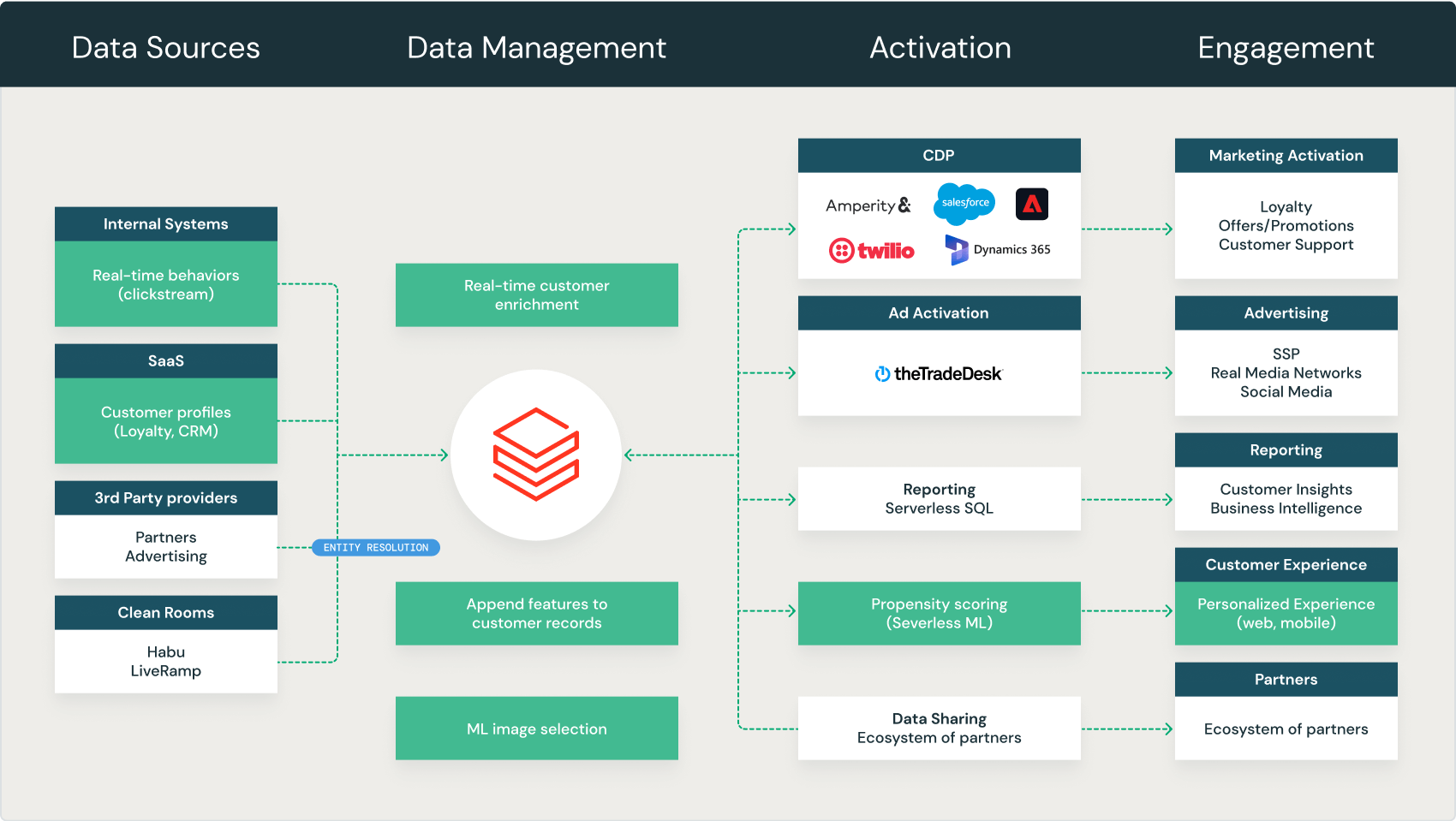Customer Insights
Explore the importance of customer insights and their impact on driving business success

Customer insights are a vital component of any successful business strategy. In today’s data-driven world, understanding customers and their needs is crucial for organizations aiming to stay competitive and relevant. By analyzing vast amounts of customer data, businesses can uncover valuable insights that drive informed decision-making, enhance customer experiences and foster long-term loyalty.
Note: Throughout this article, we use terms like “customer,” “audience” and “member” interchangeably. They represent the end user, and are typically specific to an industry (e.g., “customer” in retail, “audience” in media and entertainment, “member” in banking). When you see the term “customer,” it is equally relevant to think “audience” or “member” based on your industry and specific use cases.
What Are Customer Insights?
Customer insights refer to the in-depth understanding gained through the analysis of customer data, enabling businesses to make informed decisions and strategies based on customer needs, preferences, behaviors and motivations. By leveraging customer insights, organizations can enhance their products, services, marketing campaigns and overall customer experience.
What Are Examples of Customer Insights?
The following examples provide a glimpse into the most canonical use cases of customer insights, but the possibilities extend beyond them. Customer insights can also be applied to other areas depending on specific business needs and goals.
- Customer entity resolution: Customer entity resolution involves identifying and merging multiple data records from different sources to create a unified view of each customer. By resolving customer identities, businesses can eliminate duplicate records, gain a comprehensive understanding of individual customers and avoid inconsistencies in data analysis.
- Segmentation: Segmentation involves dividing customers into distinct groups based on shared characteristics such as demographics, purchase history, behavior patterns, or preferences. By segmenting customers, businesses can tailor their marketing strategies, create personalized experiences and target specific customer groups with relevant messaging.
- Customer lifetime value (CLV): CLV is a metric that estimates the total value a customer will bring to a business throughout their relationship. Analyzing CLV helps organizations identify their most valuable customers, allocate resources effectively, and develop strategies to maximize customer retention and loyalty.
- Propensity scoring: Propensity scoring is a technique used to predict the likelihood of a customer taking a specific action, such as making a purchase or subscribing to a service. By analyzing historical data and customer behavior patterns, propensity scoring helps businesses target customers with higher propensities and optimize marketing campaigns accordingly.
- Retention management: Retention management involves strategies and analysis aimed at reducing customer churn and increasing customer loyalty. By analyzing customer data and identifying churn indicators, businesses can proactively take measures to retain valuable customers, improve customer satisfaction and increase overall retention rates.
- Survival analysis: Survival analysis is a statistical technique used to analyze the time until an event occurs, such as customer churn. By examining customer behavior over time, businesses can identify patterns, determine the likelihood of churn and take preventive actions to retain customers.
- Churn prediction: Churn prediction models use historical customer data and machine learning algorithms to identify customers who are at risk of churning. By predicting churn, businesses can implement targeted retention strategies, such as personalized offers or proactive customer support, to mitigate customer attrition.
- Recommendation engines: Recommendation engines leverage customer data and algorithms to provide personalized product or content recommendations to customers. By analyzing past behavior and preferences, businesses can offer relevant suggestions, improve customer engagement and drive conversions.
- Customer sentiment analysis: Customer sentiment analysis involves analyzing customer feedback, reviews and social media data to understand customer opinions, emotions and attitudes toward a product, brand or service. By employing natural language processing (NLP) techniques, businesses can extract insights from unstructured data and gain a comprehensive understanding of customer sentiment. This analysis enables organizations to identify areas of improvement, address customer concerns and enhance overall customer satisfaction.
- Customer journey mapping: Customer journey mapping involves visualizing and analyzing the entire end-to-end customer experience, from initial awareness to post-purchase interactions. By mapping out touch points, interactions and customer emotions at each stage, businesses can identify pain points, bottlenecks and opportunities for improvement. Customer journey mapping helps organizations optimize the customer experience, enhance engagement and build stronger relationships with customers.
- Demand forecasting: By leveraging customer insights, businesses can forecast future demand for their products or services. Analyzing historical sales data, market trends and customer behavior patterns allows organizations to make accurate predictions, optimize inventory management, plan production schedules and improve supply chain efficiency.
- Pricing optimization: Customer insights can also inform pricing strategies by understanding customer price sensitivity, willingness to pay and competitive landscape. By analyzing customer data, businesses can optimize pricing decisions, implement dynamic pricing models, and maximize revenue while maintaining customer satisfaction and loyalty.
What Are the Benefits of Customer Insights?
Engaging in customer insights brings numerous benefits to data teams and organizations. By analyzing customer data, businesses can make more informed decisions, enhance customer understanding, deliver more targeted and personalized experiences, and gain competitive advantages through insights that help to increase customer retention and loyalty.
Common Challenges With Customer Insights
Data teams often face several common challenges when it comes to collecting, understanding and activating customer insights. These challenges include:
- Data Quality and Integration: One of the major hurdles is ensuring data quality and integrating data from multiple sources. Incomplete, inaccurate or inconsistent data can hinder the generation of reliable customer insights. Data teams need to address data quality issues, perform data cleansing, and establish robust data integration processes to ensure a unified and accurate view of customer data.
- Data Privacy and Security: Protecting customer data and complying with privacy regulations (such as GDPR or CCPA) is a critical challenge. Data teams must implement robust data privacy and security measures to safeguard customer information and ensure compliance. Balancing the need for data access with privacy concerns can be complex and requires thorough data governance practices.
- Fragmented Views of Audience: Customer data often resides in various systems or departments within an organization, leading to data silos and fragmentation. Data teams need to overcome these silos and consolidate data from different sources to gain a holistic view of customers. Often, a simple solution is unifying data on a single, open enterprise data platform such as a data lakehouse.
- Lack of Data Expertise and Skills: Extracting valuable insights from customer data requires a skilled data team. However, a shortage of data expertise or inadequate data skills can pose a challenge. Data teams need to have the necessary skills in data analysis, statistical modeling, machine learning, and data visualization to effectively interpret and communicate customer insights across stakeholders.
- Legacy Technology Unable to Scale: The availability and effectiveness of technology infrastructure and tools can impact the ability to collect, analyze and activate customer insights. Outdated or inadequate tools may limit the efficiency and scalability of data processes. Data teams should continuously assess and invest in robust technologies to support their customer insights initiatives.
- Stakeholder Alignment and Collaboration: Collaborating with various stakeholders within the organization is essential for successful customer insights activation. Data teams often face challenges in aligning with business units, marketing teams, or executive leadership to drive the adoption of insights and translate them into actionable strategies. Building strong relationships, implementing effective communication and demonstrating the value of customer insights are key to fostering collaboration.
- Data Overload and Analysis Paralysis: With the abundance of data available, data teams may face challenges in dealing with data overload and analysis paralysis. It can be overwhelming to extract meaningful insights from vast amounts of data. Prioritizing relevant data, defining clear objectives and leveraging advanced analytics techniques can help data teams overcome this challenge.
Customer Insights Best Practices
Before diving into customer insights, it’s a good idea to think of customer insights as an extension of your broader data strategy, in alignment with the organization’s business goals. Some of the common steps organizations use to develop a customer insights strategy include:
- Establishing a customer-centric culture: Foster a customer-centric culture across the organization. Encourage all teams to prioritize customer insights and data-driven decision-making. This includes promoting a mindset of continuous learning, valuing customer feedback and making customer-centricity a core part of the organizational values. By embedding a customer-focused culture, employees are more likely to embrace customer insights and act upon them.
- Aligning insights with business objectives: Ensure that customer insights align with the organization’s broader business objectives. Clearly define the strategic goals and objectives of the organization and identify how customer insights can contribute to achieving them. This alignment helps prioritize insights that are most relevant to the business and ensures that the insights drive actionable outcomes. Regularly revisit and reassess the alignment between insights and business objectives to stay agile and adaptable.
- Breaking down data silos and fostering collaboration: Encourage cross-functional collaboration and break down data silos within the organization. Promote information sharing, collaboration and communication among teams to leverage customer insights effectively. Data teams should work closely with marketing, sales, product development and customer service teams to share insights, align strategies and jointly execute initiatives. Foster a culture of collaboration and provide platforms or tools that facilitate knowledge sharing and collaboration.
- Continuously measuring, evaluating and iterating: Implement a process of continuous measurement, evaluation and iteration to refine the use of customer insights. Regularly monitor the impact of insights-driven initiatives, track key performance indicators (KPIs), and evaluate the effectiveness of strategies and actions taken based on insights. Use feedback loops and data-driven insights to inform decision-making and refine approaches over time. Encourage a culture of experimentation and learning from both successes and failures.
By implementing these best practices, organizations can effectively integrate customer insights into their decision-making processes, drive customer-centric strategies and achieve sustainable business growth. It is important to adapt these practices to the specific needs and goals of the organization and continuously evolve them as the business landscape and customer expectations change.
Customer Insights Tools
Customer insights tools are technologies that teams can use to collect, analyze, visualize and derive meaningful insights from customer data. Several companies make data automation tools, but finding the right tool for your needs can be challenging. A few key things to look for in a data automation tool include:
- Scalability: The customer insights tool should be able to quickly scale to meet the growing demands of data processing
- Observability: The tool should provide logging and monitoring capabilities to ensure data integrity and accuracy and to help with quick troubleshooting when issues arise
- Security: The tool should have robust security features, such as encryption, access controls, authentication and auditing
- Integration: The tool should seamlessly integrate with other data tools and systems, such as data warehouses, data lakes, analytics platforms and visualization tools, to enable end-to-end data automation workflows. It should also adapt to various data sources, formats and workflows.
- Ease of use: The tool should allow users to easily configure, design and manage data automation workflows without requiring extensive coding or technical skills
Customer Insights Solution Accelerators
The Databricks Lakehouse Platform is a unified set of tools for data engineering, data management, data science and machine learning. It combines the best aspects of a data warehouse, a centralized repository for structured data, and a data lake used to host large amounts of raw data.
The Databricks Lakehouse Platform includes tools to analyze customer data to gain a deeper understanding of audience needs, preferences, behaviors and motivations. Save hours of discovery, design, development and testing with Databricks Solution Accelerators. Purpose-built guides — fully functional notebooks and best practices — speed up results across your most common and high-impact use cases so you can go from idea to proof of concept (PoC) in as little as two weeks.
Learn more about Databricks Solution Accelerators for Customer Insights
Solution Accelerators for Customer Insights

Example architecture for identifying propensity to buy in real time on Databricks